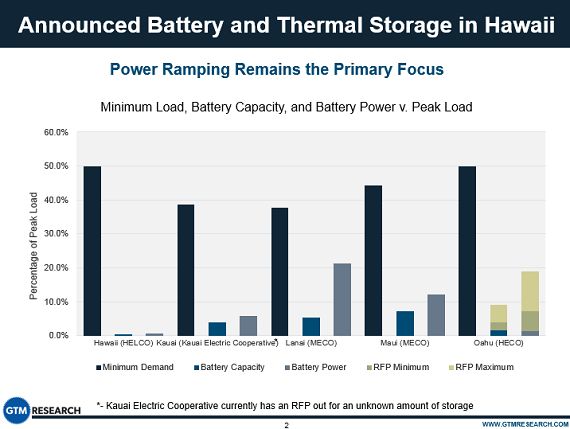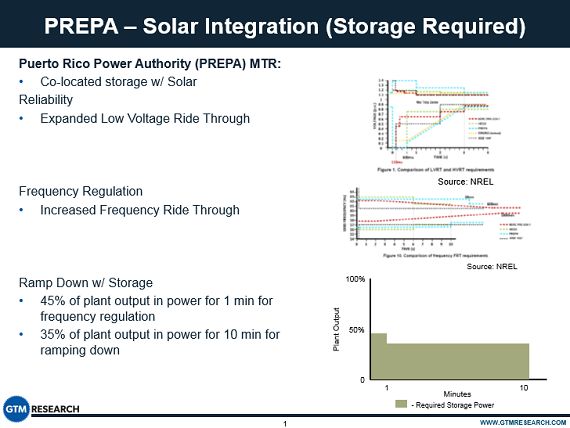Battery storage can combine the speed and granularity of power electronics with the dispatch of both real and reactive power. This gives many battery solutions significant advantages over traditional grid infrastructure and newer power electronics-based solutions, especially when used for the mitigation of the negative effects of high-penetration solar and intermittent generation sources.
However, high prices are expected to continue to limit its wide-scale deployment to remote grids, leaving opportunities for other secondary and substation-based power electronics solutions in continental grids.
FIGURE: Comparison of Big Grids and Remote Grids

Source: Advanced Grid Power Electronics for High-Penetration PV Integration, 2014
Continental grids
For continental grids such as the Eastern Interconnect, Western Interconnect and ERCOT in the United States, these costs have relegated storage to markets where FERC 755 and FERC 784 have opened up lucrative frequency regulation payments or markets with high customer demand charges. These high prices create an opportunity for cheaper grid power electronics platforms to provide the sub-cycle local power quality services that energy storage can provide so well without the direct active power benefits that energy storage solutions offer.
Through power electronics solutions, distribution utilities can target enhanced power quality services to individual feeders or individual secondary transformers. Complications arising from high-penetration distributed solar arise based on a variety of technical factors, including length of conductor, presence of reactive and voltage control apparatus, and amount of solar versus feeder peak load, among many others.
In a large interconnected grid, these problems are often limited to a local feeder, as power from the larger system greatly overshadows distributed solar generation. These local problems most commonly include sustained overvoltages, potential low-voltage inverter tripping, increased reactive power and voltage volatility, and increased harmonics. Traditional solutions for these problems often operate too slowly to be able to keep up with rapidly changing solar output and are forced to operate more often, reducing equipment lifetimes.
Grid power electronics solution provide an additional utility-controlled tool to manage this volatility at the secondary level. They provide sub-cycle correction of power quality disruptions; while enabling deeper, more granular conservation voltage reduction; and enhancing control over system power factor.
Remote grids
The isolated nature of remote and island grids drastically reduces the scale of the generation infrastructure needed. These smaller market footprints have led to waves of renewable power being integrated into island grids over the last six years, as wind and solar generation became cost-competitive with traditional generators.
These renewable waves are forcing islands and remote grids to take more drastic measures to maintain system-wide frequency stability and ensure that demand and supply remain balanced as renewables ramp up and down throughout the day. These highly variable conditions favor storage that can fill in intra-hour gaps in energy and reduce variance in ancillary services.
FIGURE: Energy Storage Application by Technology

Source: Advanced Grid Power Electronics for High-Penetration PV Integration, 2014, adapted from EPRI
In the United States and its territories, Hawaii and Puerto Rico are in the midst of one of these waves of renewables deployment. More specifically, the deployment of distributed solar is creating concerns around system reliability, economic energy dispatch, and increased renewable curtailment in Hawaii. In Puerto Rico, recently implemented minimum technical requirements have mandated storage to mitigate potential harmful effects of increasingly large quantities of intermittent generation resources.
Hawaii has been a hotbed of activity for battery energy storage firms, with nearly 48 megawatts of power and nearly 29 megawatt-hours of battery storage capacity in use on islands that have a total load of less than 1.7 gigawatts. This activity has been largely driven by co-located storage at wind plants and research projects situated on the island to integrate solar resources.
FIGURE: Energy Storage in Hawaii at a Glance

Source: GTM Research
This activity seems to be only the start of a much larger system-wide change that the Hawaii PUC is requiring HECO to analyze. Recent PUC filings have mandated examination of system generation assets and reorganization of dispatch priority based on economic variables. Additionally, the documents have instructed HECO to examine the causes of the under-frequency load-shed events that have increased drastically on Hawaii and Molokai, causing declines in system reliability. These efforts could push HECO to become what some might call a distribution system operator, with the task of ensuring reliability, while managing a variety of customer and distribution grid-sited energy resources.
Similarly, the Puerto Rico Electric Power Authority has made one of the first moves to tie the deployment of solar to the deployment of battery storage, creating minimum storage requirements for solar projects. These requirements augment IEEE 1547 interconnection standards to expanded voltage and frequency tolerances, and to mandate improved ramping management. These requirements will drastically improve system reliability and reduce the chance of loss of generation due to inverter tripping. However, the cost of using these systems to supplement solar facilities will likely remain unpalatable to solar providers in the more competitive continental United States, where solar PPAs have reached 5 cents per kilowatt-hour, a far cry from Puerto Rico’s base cost of 29 cents in 2011, according the EIA.
FIGURE: PREPA Minimum Technical Requirements

Source: GTM Research
Batteries will be an important but expensive tool for facilitating solar integration for some time to come. There is also ample space in the market for other solutions, such as utility-owned secondary power electronics.
GTM Research's latest report, Advanced Grid Power Electronics for High-Penetration PV Integration, 2014, offers a deeper look at the potential for grid power electronics to provide an alternative to battery energy storage solutions.
***
Grid Edge Live will feature panels on advanced power electronics and distributed storage systems. See the full agenda here.



